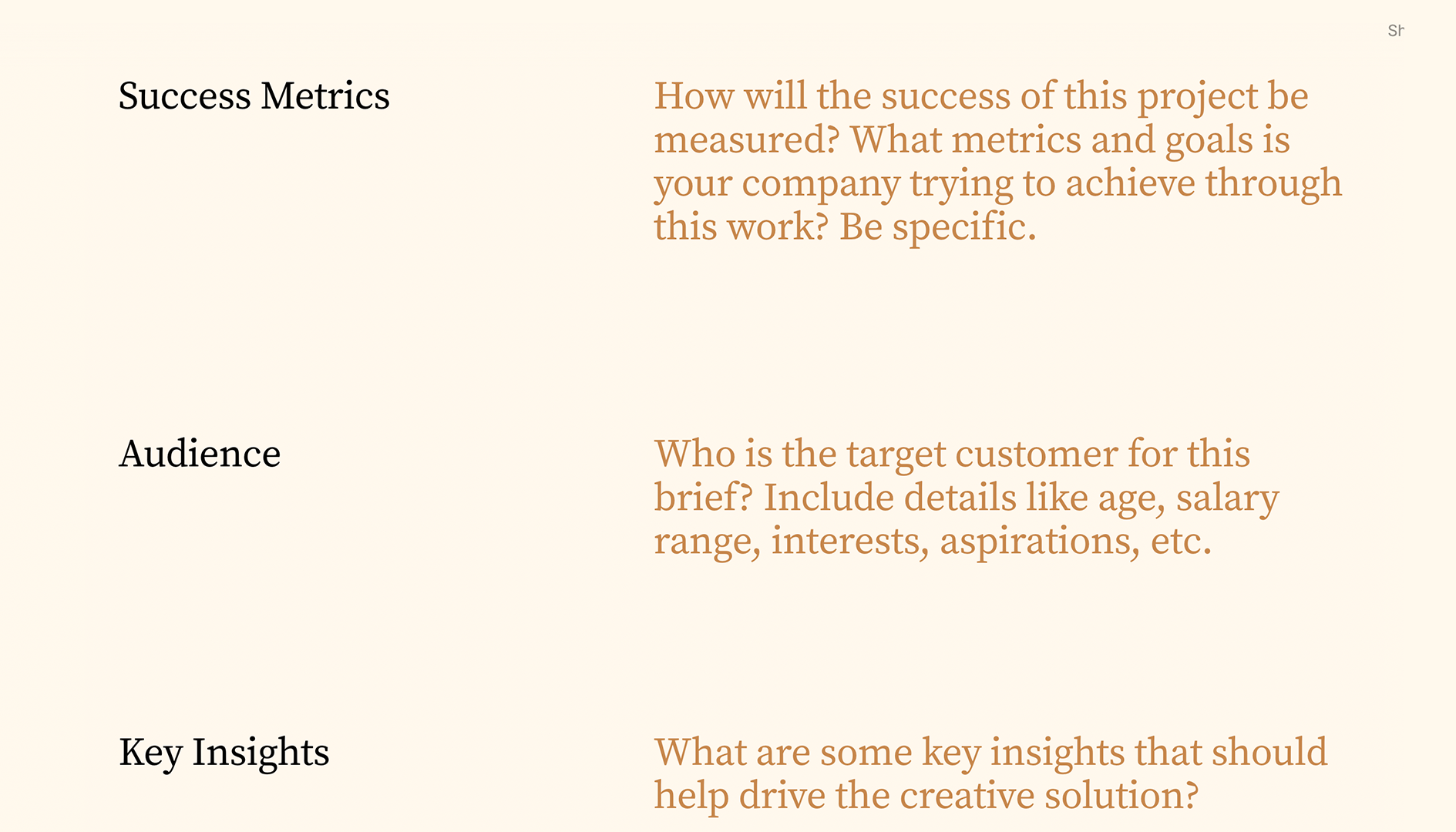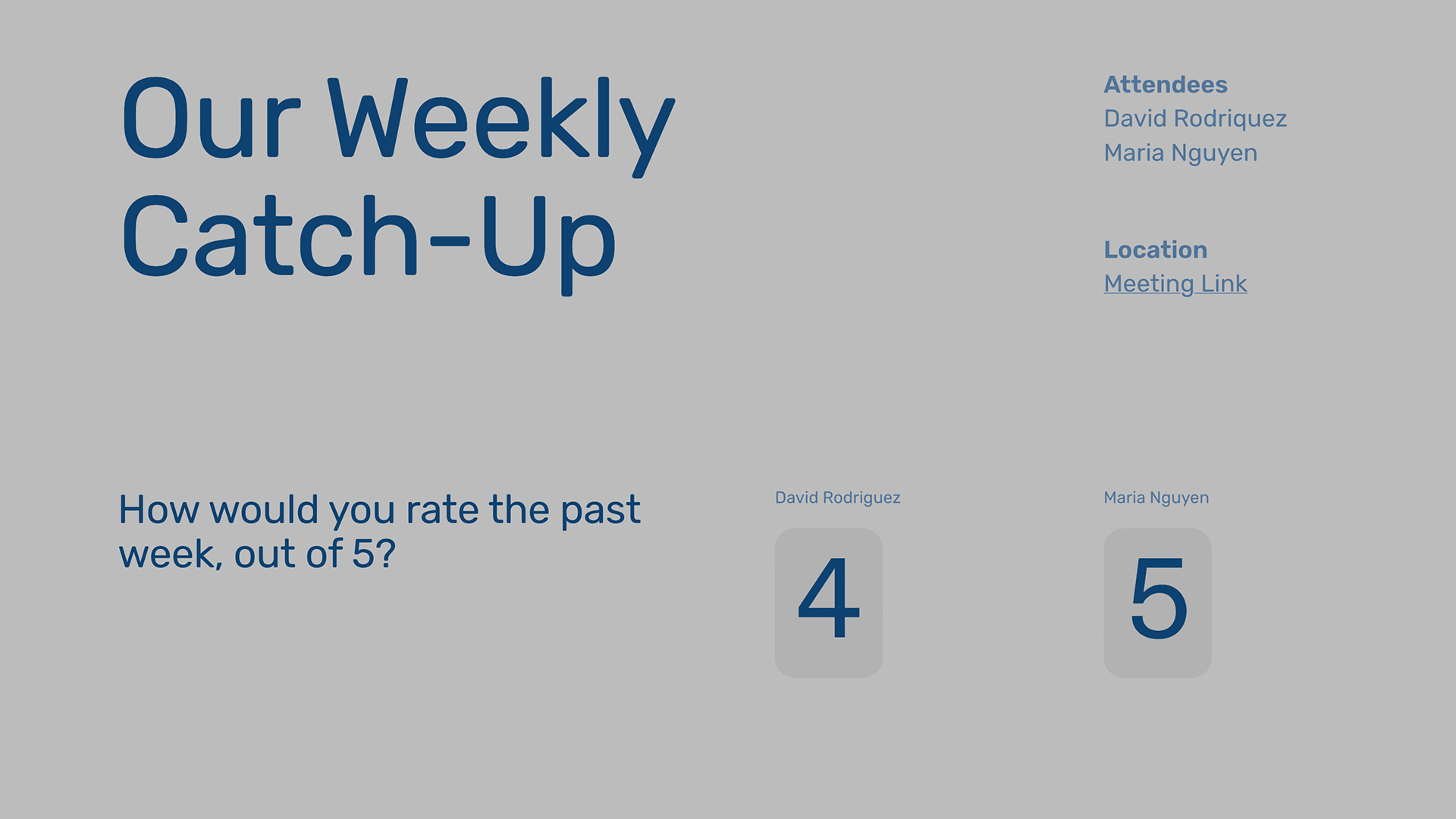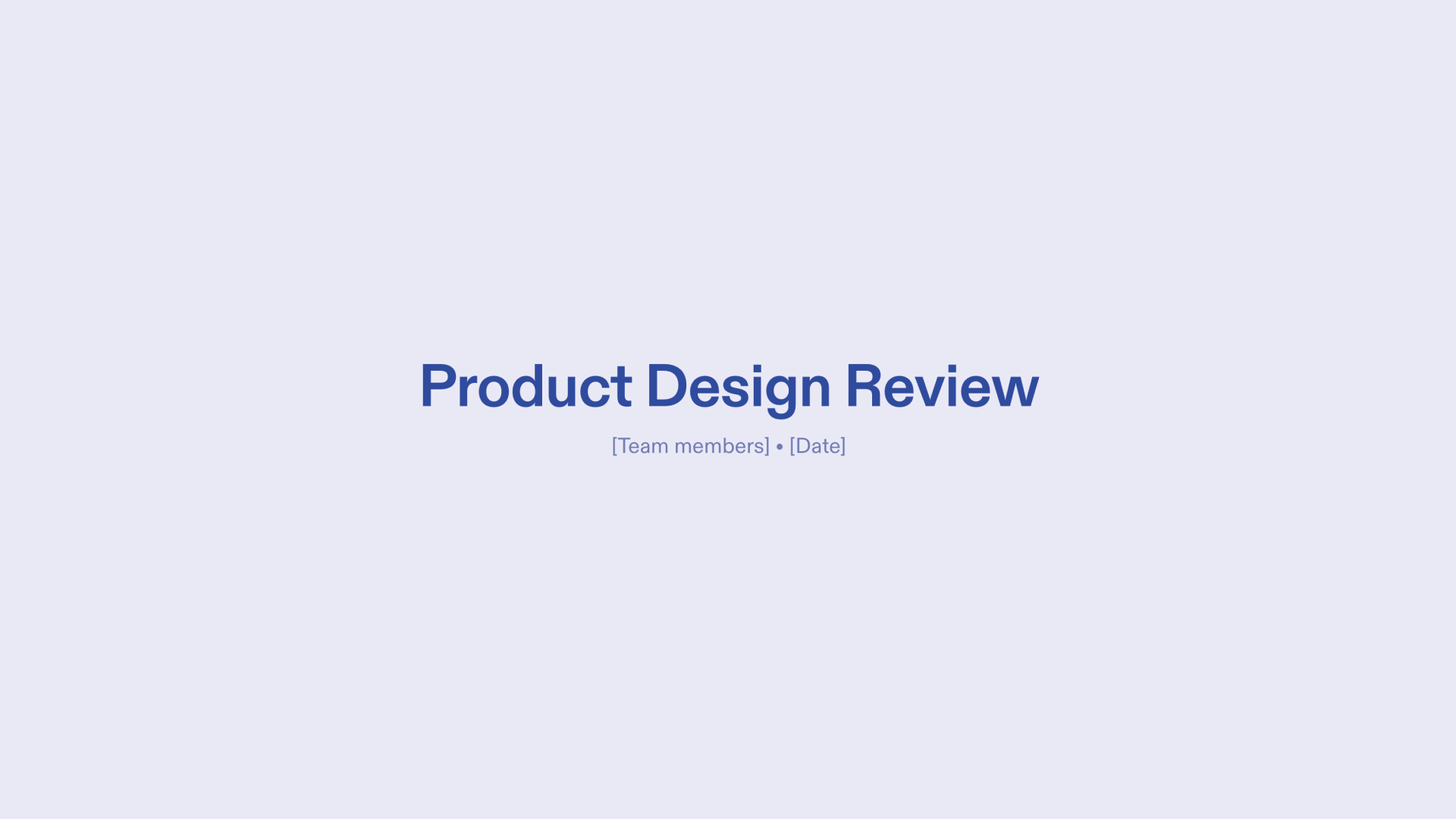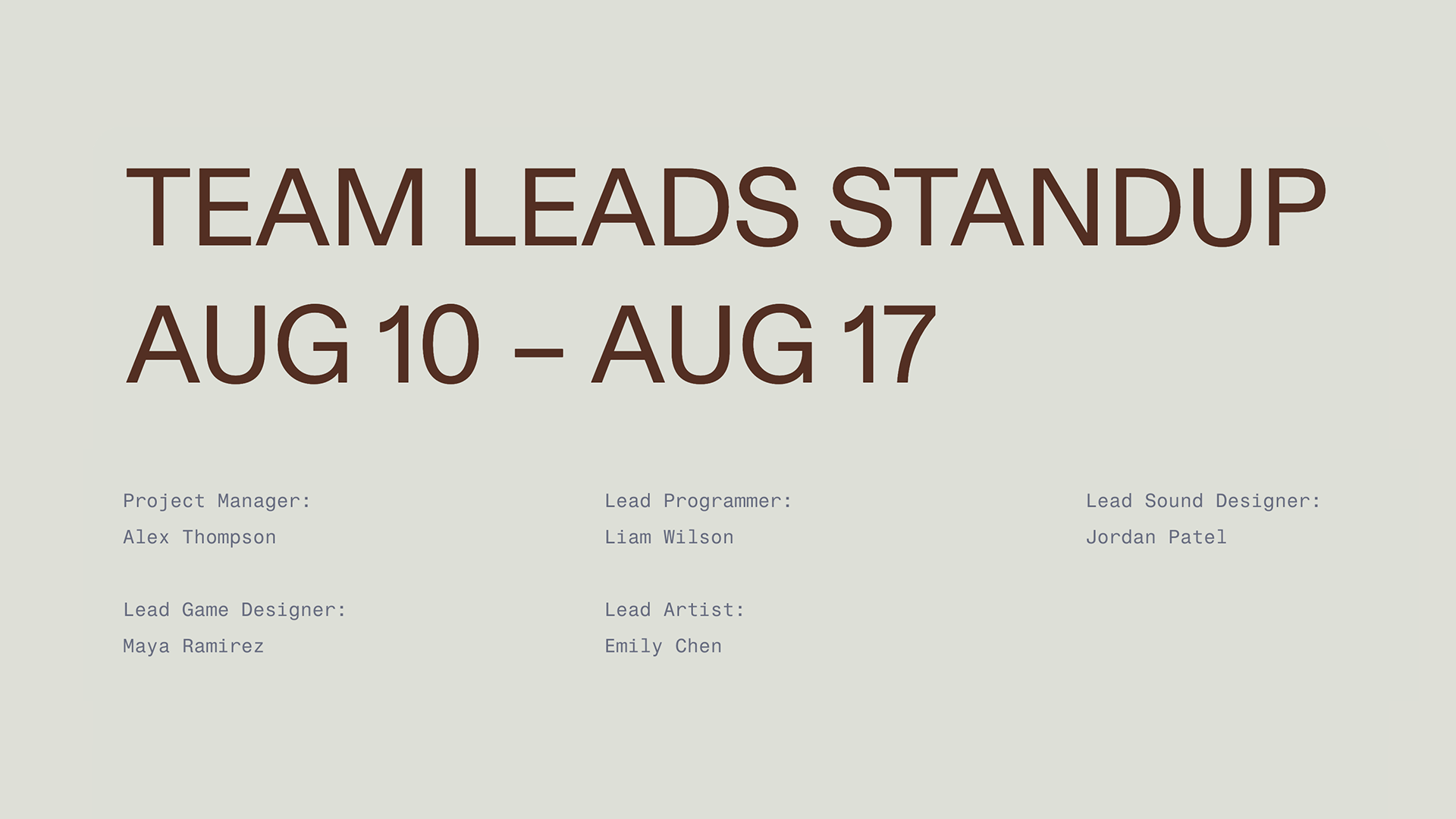Creative Brief
Use Tome’s Creative Brief template to give stakeholders all the insights needed to successfully craft a campaign.
About this template
This template guides you through compiling a helpful base camp for a campaign. It's designed with a simple, easy-to-use format that breaks each component down into clear sections. First, lay the groundwork with the business context, objectives, and success metrics, then move into the audience breakdown, key insights, and creative strategy. You can insert a project timeline hosted on Miro or another website. All fonts, colors and themes are customizable.
Template outline
- Business Context
- Objective
- Success Metrics
- Audience
- Key Insights
- Key Messages
- Creative Strategy
- Timeline
- Budget
Tell a powerful story
- Editable with AI
- Beautiful typography
- AI layout generation
- Narrative Guidance
- Automatic mobile layout
- AI reference sourcing
- Share or link anywhere
- Downloadable as a PDF
- Real-time collaboration
What is a Creative Brief?
Think of a creative brief as your project's cheat sheet—it's the go-to document that lays out the project in a nutshell. Marketing and design teams particularly use these briefs to help everyone grasp the project mission, its challenges, and its messaging.
But these briefs aren’t just for in-house teams. Stakeholders also gain significant value from these documents, including aligning project teams and stakeholders on campaign goals and expectations.
A well-thought-out brief identifies potential risks of the campaign early on. Laying out any challenges upfront makes it easier for your team to develop risk-mitigation strategies, which saves time and money down the line. Not to mention, it’s much easier for decision-makers to keep the project moving forward when they can reference a brief.
No matter if you're a seasoned advertiser or a project manager still trying to get organized, a brief keeps everyone on the same page. Most importantly, a brief helps you capture the story you want to tell and bring it to life.
What to include in a creative brief
Creative briefs are versatile to help meet the scope of your project. While knowing what to include can be a challenge, tailoring your creative brief to suit your needs is what makes it effective.
When you have a great template to start with, you’ll discover what matters most for your project. The sections below are included in our creative brief template to help you structure your ideas and remember to include key elements.
Context
To make your project objectives more compelling, it’s best to provide some background. This ensures that your audience and internal team understand the project’s origins and any other relevant information. The project becomes more cohesive when everyone knows the “why.”
Tome’s template has a “Business Context” section that fulfills this need, urging you to provide an overview of the organization and team of the project. This section may include information such as the company's mission, vision, values, industry background, competitive landscape, and recent developments relevant to the project. Once you cover these details, you can jump into the project framework.
Objective
This next step is to make the project’s objective clear and compelling. Doing so helps focus all of the efforts of the team and provides a benchmark for success. Having a clear intent is another way you can better present the project to stakeholders. Any involved parties should understand the goal and what achieving that goal means for the organization.
How do you capture your objective in a brief? One key element is making your objective, or goal, measurable. In fact, your goal should follow all SMART standards: Specific, Measurable, Achievable, Relevant, and Time-bound. Tome’s template helps you outline the goal’s key elements, such as its scope and the tasks involved in completing it.
Metrics
Metrics are the measuring tape for your goals and project progress. By using metrics, you quantify your progress and assess the performance of your project. This can be great for showing stakeholders the potential of your project—and how you will keep your team accountable for their work.
Use the “Success Metrics” section from Tome’s template to list any key performance indicators (KPIs) and how they relate to your objectives. For example, this could include metrics like:
- Website traffic
- Engagement rates
- Conversation rates
- Sales figures
Audience
One of the best aspects to cover in your brief is your target audience. Your audience serves as the linchpin of your project, shaping its direction and ensuring your messaging remains aligned with your brand. When you understand your audience’s behaviors and preferences, you’re far more likely to make your project effective.
The template’s audience section is the perfect place to outline these details. A thorough profile often includes demographic information and psychographic insights. Here you consider: What does this group need? What captures their attention? How is your project solving their pain points? These questions help boost the impact of your project on your audience.
Key Insights
In addition to key metrics, it’s also wise to include key insights and research. This is a great place to gather some of your data-driven highlights, such as any statistics on your target audience, market trends, and the competitive landscape.
Tome’s template has a dedicated section for this where you can summarize the most relevant research and data points. When you provide this information, you join the ambitions of your creative project with the realities of the marketplace. Plus, stakeholders will find your campaign far more persuasive if you provide evidence of why you’ll succeed.
Creative Strategy
Next, spotlight your original and innovative solutions in the creative strategy section. Design considerations or goals? Messaging and tone? This section guides your project execution and ensure that your creative outputs resonate with your audience.
With Tome’s template, you communicate these creative elements both in text and visuals. Whatever represents the artistic vision of your campaign, this is where to include it in your brief. From brand voice to visual style to media channel optimization, the creative strategy is where your story really takes flight.
Timeline
Don’t forget to add a realistic timeline for your project execution. It’s helpful to have some parameters for when deliverables should be completed and how they fit into the budget. A well-defined timeline does just this, as well as managing expectations and allocating resources accordingly.
Tome’s template offers a dedicated timeline section where you can highlight key milestones, potential bottlenecks, deadlines, and any dependencies associated with the project. These could be tasks like:
- Research
- Concept development
- Design interactions
- Client review cycles
- Production
- Deployment
Budget
Finally, don’t forget to include your budget in your creative brief. Every project has budget constraints, which helps you manage costs and prioritize your investments. A budget also shows your stakeholders and investors that you use your resources judiciously—and that the campaign will pay off monetarily.
With the Creative Brief template, you can include your target budget for the project and offer a detailed table breakdown. This may have items like personnel costs, production expenses, marketing expenses, and any other expenditures.
How to write a creative brief in 10 steps
Now that you know what should be covered in a creative brief, it’s time to actually create one. Here’s a list of basic steps that can guide you through the process:
- Draft a Project Summary: Start by providing an engaging but brief overview of the project's purpose and expected outcome to set the stage for all stakeholders involved.
- Clarify Stakeholder Expectations: Clearly identify and document the expectations of stakeholders to stay in alignment and avoid misunderstandings. This protects the team from time- and money-wasting.
- Detail the Communication Strategy: Outline how the project will communicate its message. You can include channels, media, and key messages, to effectively reach the target audience.
- Identify Project Challenges: Show that you expect and can mitigate challenges. Discuss any anticipated obstacles and include strategies for addressing them within the creative brief.
- Establish Creative Guidelines: Set parameters for the creative execution, including tone, style, and key branding elements. This ensures consistency across deliverables and tasks.
- Plan Resource Allocation: Specify the resources required for each phase of the project, including people, tools, and time tasks will take. Then, outline the budget and resources you will need.
- Incorporate Feedback Loops: Incorporate checkpoints for reviewing progress and integrating feedback from stakeholders.
- Document Approval Processes: Outline how and when you plan on getting deliverables reviewed and approved by the necessary parties. This will streamline decision-making and avoid delays.
- Include a CTA: Close out the creative brief with a motivating call to action for the project team. This is a good time to highlight any next steps and rally everyone for success.
- Review and Revise: Don’t forget to have a final review of the creative brief for clarity, completeness, and alignment with project goals.
Creative Brief Example
If you want to see this creative brief template in action, here’s a hypothetical example of what the details of a creative brief can look like.
Context:
Our company, CleanTech Solutions, is launching a new environmentally-friendly cleaning product called "EcoClean" targeting eco-conscious consumers. With increasing demand for sustainable alternatives, this product aims to capitalize on the growing market for green cleaning solutions.
Objective:
To drive awareness and sales of "EcoClean" by achieving a 20% increase in market share within the first six months of launch.
Metrics:
The key metrics we are aiming to achieve and measure include:
- Increase in sales revenue by 30% compared to previous product launches.
- Achieve a 15% increase in website traffic and a 10% conversion rate from website visitors to purchasers.
- Garner a minimum of 100 positive customer reviews on relevant platforms within the first three months.
Audience:
Primary Audience: Environmentally-conscious consumers aged 25-45, predominantly urban dwellers with disposable income. This group prioritizes sustainability and seeks eco-friendly alternatives in their purchasing decisions.
Key Insights:
- Market research indicates a growing trend towards eco-friendly products, particularly among millennials and urban professionals.
- Competitor analysis reveals gaps in the market for affordable, effective, and environmentally friendly cleaning solutions.
- Consumer surveys highlight concerns about the environmental impact of traditional cleaning products and a willingness to pay a premium for sustainable alternatives.
Creative Strategy:
Develop a multi-channel campaign focusing on the product's eco-friendly features, efficacy, and affordability, emphasizing its positive impact on both homes and the environment.
Utilize storytelling elements to create emotional connections with the audience, showcasing real-life scenarios where "EcoClean" makes a difference.
Leverage social media influencers and eco-friendly lifestyle bloggers to amplify the message and reach target audiences organically.
Timeline:
- Research and Planning: 2 weeks
- Campaign Development: 4 weeks
- Production and Implementation: 6 weeks
- Launch and Monitoring: Ongoing
Budget:
- Marketing Materials: $20,000
- Digital Advertising: $30,000
- Social Media Influencers: $15,000
- PR Campaign: $10,000
- Total Budget: $75,000
Elevate your creative brief with AI
A well-designed creative brief can make all of the difference in your campaign’s trajectory. It can set your team up for success, generate support from leaders and stakeholders, and ultimately make your creative endeavors shine.
Once you gather your research and data, presenting your brief is another matter entirely. A campaign or project brief is more than just a document—it’s how you share your aspirations and business ideas with the world. That level of storytelling requires intentional and compelling work, which is where Tome’s Creative Brief template comes in.
Tome's AI-powered template makes the brief creation process both easy and efficient. With AI assistance, creators benefit from streamlined design, optimized layouts, refined messaging, and even seamless reference sourcing. The technology works alongside creators as a collaborator, offering suggestions and adapting to your evolving needs.
Tell your story with Tome and make your campaign irresistible. Use the template today to build out your engaging and cohesive brief.










